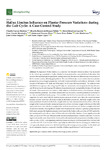Hallux Limitus Influence on Plantar Pressure Variations during the Gait Cycle: A Case-Control Study

Use este enlace para citar
http://hdl.handle.net/2183/34663Coleccións
- GI-UDISAP - Artigos [186]
Metadatos
Mostrar o rexistro completo do ítemTítulo
Hallux Limitus Influence on Plantar Pressure Variations during the Gait Cycle: A Case-Control StudyAutor(es)
Data
2023-06-27Cita bibliográfica
Cuevas-Martínez, C.; Becerro-de-Bengoa-Vallejo, R.; Losa-Iglesias, M.E.; Casado-Hernández, I.; Navarro-Flores, E.; Pérez-Palma, L.; Martiniano, J.; Gómez-Salgado, J.; López-López, D. Hallux Limitus Influence on Plantar Pressure Variations during the Gait Cycle: A Case-Control Study. Bioengineering 2023, 10, 772. https://doi.org/ 10.3390/bioengineering10070772
Resumo
´[Abstract] Background: Hallux limitus is a common foot disorder whose incidence has increased
in the school-age population. Hallux limitus is characterized by musculoskeletal alteration that
involves the metatarsophalangeal joint causing structural disorders in different anatomical areas of
the locomotor system, affecting gait patterns. The aim of this study was to analyze dynamic plantar
pressures in a school-aged population both with functional hallux and without. Methods: A full
sample of 100 subjects (50 male and 50 female) 7 to 12 years old was included. The subjects were
identified in two groups: the case group (50 subjects characterized as having hallux limitus, 22 male
and 28 female) and control group (50 subjects characterized as not having hallux limitus, 28 male and
22 female). Measurements were obtained while subjects walked barefoot in a relaxed manner along a
baropodometric platform. The hallux limitus test was realized in a seated position to sort subjects
out into an established study group. The variables checked in the research were the surface area
supported by each lower limb, the maximum peak pressure of each lower limb, the maximum mean
pressure of each lower limb, the body weight on the hallux of each foot, the body weight on the first
metatarsal head of each foot, the body weight at the second metatarsal head of each foot, the body
weight at the third and fourth metatarsal head of each foot, the body weight at the head of the fifth
metatarsal of each foot, the body weight at the midfoot of each foot, and the body weight at the heel
of each foot. Results: Non-significant results were obtained in the variable of pressure peaks between
both study groups; the highest pressures were found in the hallux with a p-value of 0.127 and in the
first metatarsal head with a p-value 0.354 in subjects with hallux limitus. A non-significant result
with a p-value of 0.156 was obtained at the second metatarsal head in healthy subjects. However,
significant results were observed for third and fourth metatarsal head pressure in healthy subjects
with a p-value of 0.031 and regarding rearfoot pressure in subjects with functional hallux limitus with
a p-value of 0.023. Conclusions: School-age subjects with hallux limitus during gait exhibit more
average peak plantar pressure in the heel and less peak average plantar pressure in the third and
fourth metatarsal head as compared to healthy children aged between 7 and 12 years old.
Palabras chave
Gait analysis
Hallux limitus
School age
Plantar pressure
Análisis de la marcha
Edad escolar
Presión plantar
Hallux limitus
School age
Plantar pressure
Análisis de la marcha
Edad escolar
Presión plantar
Versión do editor
Dereitos
Atribución 3.0 España






